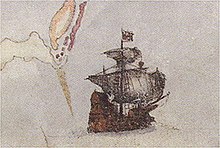
Action off Bermuda (1585)
| Action off Bermuda | |||||||
|---|---|---|---|---|---|---|---|
| Part of the Anglo–Spanish War | |||||||
 English ship Tiger | |||||||
| |||||||
| Belligerents | |||||||
|
|
| ||||||
| Commanders and leaders | |||||||
| Richard Grenville | Alonzo de Cornieles | ||||||
| Strength | |||||||
|
160-ton galleass
|
300- to 400-ton galleon
| ||||||
| Casualties and losses | |||||||
| 2 wounded |
1 galleon captured 10 killed or wounded, 280 captured[2] | ||||||
The action off Bermuda, also known as Grenville's action off the Bermuda's, was a minor naval engagement that took place off the island of Bermuda over three days in late August 1585 during the Anglo–Spanish War between an English galleass, Tiger, and a larger Spanish galleon, Santa Maria de San Vicente.[3] Tiger was victorious when the Spanish ship surrendered after a severe bombardment.[4]

Background
In April 1585, English Admiral Richard Grenville was in charge of a seven-strong fleet that brought English settlers to establish a military colony on Roanoke Island. This had been founded by Sir Walter Raleigh, off the Western coast of North America (modern-day North Carolina).[5] War had already been declared by Philip II of Spain after the Treaty of Nonsuch in which Elizabeth I had offered her support to the Protestant Dutch rebels. In August the 160-ton English ship Tiger or Tyger of twenty two guns (which had been converted into a galleass) under Grenville began her voyage back to England from the 1585 Roanoke Expedition.[6]

On 31 August 1585 the Tiger after only the seventh day of sail sighted a ship; upon closer inspection it turned out to be a Spanish ship, and eventually caught up with her.[7]

Battle

The Spanish ship fired off a friendly salute, and as soon as the ship was in range, the Tiger opened fire.[8] The Spanish ship was the Santa Maria de San Vicente, the flagship of the Santo Domingo squadron of the Spanish Flota, captained by Alonzo de Cornieles.[7] At near 400 tons Santa Maria de San Vicente was a richly-laden galleon having sailed from Havana with nearly 300 crew, soldiers, and passengers.[6] She was struggling to catch up with the main convoy of thirty ships much farther ahead, having been forced to heave-to by gale-force winds.[9]

Grenville soon realised that the size of the Santa Maria de San Vicente was much larger (200 tons bigger) than his own ship. The Tiger sought to close and use her guns to pound the ship into submission rather than board, which was Grenville's initial strategy. Cannon fire from the Tiger soon found their target and sent shot firstly into the rigging of Santa Maria de San Vicente. She was hit by a number of broadsides from the Tiger, and a further shot holed her below the waterline. For three days the Santa Maria managed to put up with incessant attacks from Tiger but was unable to reply effectively as her guns were falling well short of the English vessel.[1] Unable to tolerate the bombardment any more the Santa Maria de San Vicente turned around and attacked. She attempted to board, but the Tiger kept a good distance putting up stout resistance. The English ship, despite being outnumbered, was able to gain the upper hand by pounding the Spanish ship into submission.[10]

Tiger began to have some sustained damage, and the English decided to act. With crates and sheathing from the Tiger, English sailors created a raft and used it to assault the Spanish ship. Cornieles seeing that he was in a desperate situation having already been holed and suffered heavy damage, then surrendered.[2] The twenty men on the makeshift raft sank just as they landed on board.[1]

The Spanish had suffered ten casualties in all, while the English had only two wounded. The Spanish prisoners were transferred to the Tiger, and the two ships travelled together, bound for England.[5]

Aftermath
On the journey home both ships endured high seas and storms - the prisoners were dropped off at the Azores islands under oath. The Santa Maria de San Vicente was taken into Bideford amid much rejoicing. Grenville officially valued the prize at 15,000 pounds, making the voyage a large profit. The capture was vital for underlining Grenville and Raleigh's case that colonization and exploration could be financed through privateering.[8] Over 40,000 ducats worth of gold, silver, and pearls” along with cochineal, ginger, sugar, and ivory were discovered in the large hold.[2] On the other hand, the Spanish estimated the value of the vessel at 50,000 pounds, and it was rumoured by some to have been worth as much as one million ducats.[7] This spurred accusations against Grenville of embezzlement. Santa Maria was converted into a galleon known as the Galleon Dudley. Three years later both Tiger and the Galleon Dudley fought during the defeat of the Spanish armada.[11]

Pedro Diaz, a pilot of the Santa Maria de San Vicente', was kept as a prisoner by the English, who brought him along on the 1586 Roanoke Voyage, of which he kept a detailed journal which proved useful in knowledge of that expedition.[11]

The cannons from Santa Maria de San Vicente were discovered by the quayside of Bideford in 1895. They were then placed in Bideford's Victoria Park only to be erroneously labelled 'Amada cannons'.[12]

References
- Citations
- ^ a b c Horn p 83-84
- ^ a b c Bradley pp 272-73
- ^ Hakluyt Society (1967). Works, Volumes 104-105. pp. 169 & 786.
- ^ Marley (2008) p 116
- ^ a b Quinn pp 85-86
- ^ a b Kupperman pp 23-24
- ^ a b c Bicheno pp 180-81
- ^ a b Miller p 104
- ^ Navarrete, Martín Fernández de (1851). Biblioteca marítima española: obra póstuma del excmo, Volume 1. Imprenta de la Viuda de Calero. (Spanish)
- ^ Canny pp 91-92
- ^ a b Powell p.14
- ^ A pictorial and descriptive guide to Ilfracombe, Barnstaple, Bideford, Woolacombe, and north-west Devon. Ward, Lock and Company, ltd. 1926. p. 12.
- Bibliography
- Bicheno, Hugh (2012). Elizabeth's Sea Dogs: How England's Mariners Became the Scourge of the Seas. Conway. ISBN 978-1844861743.
- Bradley, Peter T (2010). British Maritime Enterprise in the New World: From the Late Fifteenth to the Mid-eighteenth Century. Edwin Mellen Press. ISBN 978-0773478664.
- Canny, Nicholas, ed. (2001). The Oxford History of the British Empire: Volume I: The Origins of Empire. Oxford University Press Oxford. ISBN 9780191647345.
- Dean, James Seay (2013). Tropics Bound: Elizabeth's Seadogs on the Spanish Main. The History Press. ISBN 9780752496689.
- Horn, James (2010). A Kingdom Strange: The Brief and Tragic History of the Lost Colony of Roanoke. Basic Books. ISBN 9780465021154.
- Kupperman, Karen Ordahl (2007). Roanoke: The Abandoned Colony. Rowman & Littlefield. ISBN 9780742552630.
- Marley, David (2005). Historic Cities of the Americas: An Illustrated Encyclopedia, Volume 1. ABC-CLIO. ISBN 9781576070277.
- Miller, Lee (2001). Roanoke: Solving the Mystery of the Lost Colony. Arcade Publishing. ISBN 9781559705844.
- Powell, Andrew Thomas (2011). Grenville and the Lost Colony of Roanoke. Troubador Publishing Ltd. ISBN 9781848765962.
- Quinn, David B (1985). Set Fair for Roanoke: Voyages and Colonies, 1584-1606. UNC Press Books. ISBN 9780807841235.
See what we do next...
OR
By submitting your email or phone number, you're giving mschf permission to send you email and/or recurring marketing texts. Data rates may apply. Text stop to cancel, help for help.
Success: You're subscribed now !
